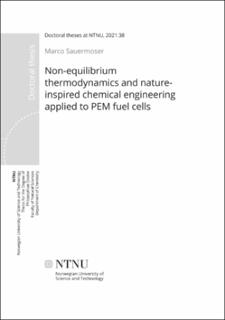| dc.contributor.advisor | Kjelstrup, Signe | |
| dc.contributor.advisor | Pollet, Bruno G. | |
| dc.contributor.author | Sauermoser, Marco | |
| dc.date.accessioned | 2021-02-18T12:09:48Z | |
| dc.date.available | 2021-02-18T12:09:48Z | |
| dc.date.issued | 2021 | |
| dc.identifier.isbn | 978-82-326-4752-1 | |
| dc.identifier.issn | 2703-8084 | |
| dc.identifier.uri | https://hdl.handle.net/11250/2728916 | |
| dc.description.abstract | The first objective of this thesis is to discover potentials for the optimisation of the performance of polymer electrolyte membrane (PEM) fuel cells by using new designs for the flow field plates (FFP) based on nature-inspired chemical engineering. The second objective is to give a detailed understanding of the processes and effects, mostly heat-related ones, inside a PEM fuel cell.
Flow field designs were reviewed to obtain a better understanding of the demands of efficient flow patterns. Each type of pattern has advantages and disadvantages; therefore, multi-criteria optimisation methods were recommended to optimise flow field designs.
The next step was to analyse nature-inspired flow field patterns. A tree-like structure approach was chosen due to its uniform flow distribution. These patterns, usually scaled with the so-called Murray's Law, already showed promising results in PEM fuel cells compared to industry-standard serpentine patterns. Analytical calculations and 3D CFD simulations were used to calculate the entropy production of the tree-like structure. Results showed that Murray's Law did not yield minimum entropy production and increasing the width scaling factor reduced the entropy production.
Based upon the theoretical work on the tree-like patterns, a new two-layer FFP was developed and milled in high-quality graphite plates. Three different designs were tested in a 25 cm2 PEM fuel cell, and experimental results were compared to a standard 1-channel serpentine pattern. We showed that the best tree-like FFP design could achieve a peak power density which was within 11% (a 0.08 W/cm2 difference) of the serpentine pattern at 70% relative humidity. The electrochemical impedance spectroscopy and fuel cell experiments indicated that water accumulation, together with a slight increase in single PEM fuel cell resistance, were the main reasons for the reduced power density. Furthermore, we showed that decreasing the tree-like patterns' width scaling factor improved the PEM fuel cell performance.
For the second objective, a 1D PEM fuel cell model was developed to compute concentration, temperature, heat flux and electrical potential profiles inside the PEM fuel cell. A consistency check based upon the entropy balance was implemented to detect inconsistencies within the model. Further improvements were made by modifying an open-source code with our equations. The importance of coupling terms, such as Peltier or Dufour effects, which are commonly neglected, were investigated. We reported that they have significant contributions to various fluxes. Additionally, studies on varying the system boundaries' temperatures indicated that the system was susceptible to temperature changes. While having a cooler cathode, heat fluxes were more uniform in the PEM fuel cell, and cell voltages increased between 1 mV and 3 mV. | en_US |
| dc.language.iso | eng | en_US |
| dc.publisher | NTNU | en_US |
| dc.relation.ispartofseries | Doctoral theses at NTNU;2021:38 | |
| dc.relation.haspart | Paper 1: Sauermoser, Marco; Kizilova, Nataliya; Pollet, Bruno; Kjelstrup, Signe. Flow field patterns for proton exchange membrane fuel cells. Frontiers in Energy Research 2020 ;Volum 8:13. s. 1-20 | en_US |
| dc.relation.haspart | Paper 2: Sauermoser, Marco; Kjelstrup, Signe; Kizilova, Nataliya; Pollet, Bruno; Flekkøy, Eirik Grude. Seeking minimum entropy production for a tree-like flow-field in a fuel cell. Physical Chemistry, Chemical Physics - PCCP 2020 ;Volum 22. s. 6993-7003 | en_US |
| dc.relation.haspart | Paper 3: Sauermoser, Marco; Pollet, Bruno; Kjelstrup, Signe; Kizilova, Nataliya. Scaling factors for channel width variations in tree-like flow filed patterns for polymer electrolyte membrane fuel cells - An experimental study. Submitted to Journal of Power Sources Advances. This manuscript version is made available under the CC-BY-NC-ND 4.0 license. | en_US |
| dc.relation.haspart | Paper 4: Sauermoser, Marco; Kizilova, Natalya; Kjelstrup, Signe; Fossati, Giulio. Modelling Electrochemical Cells with Porous Electrodes. The Proton Exchange Membrane Fuel Cell. ECS Transactions 2019 ;Volum 92.(8) s. 279-292 | en_US |
| dc.relation.haspart | Paper 5: Sauermoser, Marco; Kjelstrup, Signe; Pollet, Bruno. The Impact of Peltier and Dufour Coefficients on Heat Fluxes and Temperature Profiles in the Polymer Electrolyte Fuel Cells. Journal of the Electrochemical Society 2020 ;Volum 167.(14) s. - | en_US |
| dc.title | Non-equilibrium thermodynamics and nature-inspired chemical engineering applied to PEM fuel cells | en_US |
| dc.type | Doctoral thesis | en_US |
| dc.subject.nsi | VDP::Matematikk og Naturvitenskap: 400::Kjemi: 440 | en_US |
